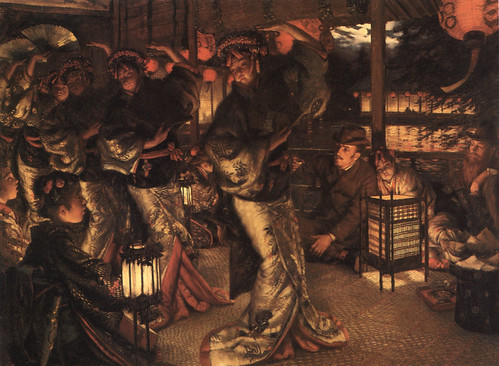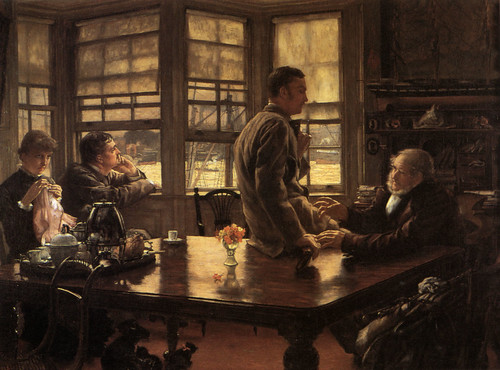
After such a long absence, I thought it fitting to make this post’s topic reflect both my sincere repentance at not having actively updated the blog and my hopes that I’ll be forgiven by those who have been patiently waiting for any sign I was still alive.
I have been in deep-research mode, and have a number of exciting things to share. Next week, I’ll begin off-loading a number of the projects I am doing on the blog and, hopefully, reignite a dialogue with many of you.
Tissot’s Prodigal Son in Modern Life
James Tissot (French, 1836-1902) is largely remembered for his scenes and portraits of the upper-middle class, but, during the 1880s he had a religious awakening and produced a number of works inspired by the New Testament. In 1885, he had what he referred to as an “epiphany” and “revelation” that lead him on a pilgrimmage to cathedrals in France and to create a series of 35 scenes from the life of Christ.

During this religious decade Tissot did multiple version of the Prodigal Son. This particular series is titled “The Prodigal Son in Modern Times” and consists of three paintings all set in contemporary English life. They were exhibited at a one-man show at the Dudley Gallery (London) in May of 1882 and accompanied by watercolor sketches of the same paintings and etchings that were later reproduced widely in England.

Shortly after the show, Tissot returned to France and took the three original oils with him. They remained in his studio until his death in 1902 and were, then, offered to the Louvre, which would not take them. Instead, the three paintings were taken by Musée de Nantes, located in Tissot’s hometown, where they remain today.
So happy you’re back! I wonder if you know the painting of Jean-Marie Janmot, a lyonnais whom I first saw at the Musee des beaux-arts there. Intensely religious academic painting. I say it crosses the Camp barrier — but what do you say?
Thank you. I’ve felt extremely guilty for having been gone so long. It’s wonderful to know I didn’t lose you.
I’m embarrased to say that I have never been to the Musée des Beaux-Arts of Lyon! Looking online I found this by L. Janmot (there seems to be some confusion on the museum’s website about L. and J.M Janmot. Is it possible they are the same person?):http://www.latribunedelart.com/Nouvelles_breves/Breves_2007/7_07/Janmot_Christ.JPG. Is that the piece you are thinking of? If not, please let me know if you can find an image.
If it is the same piece, my off-hand reaction is that it is a strange painting. It is a nineteenth-century artists painting n an archaic style. Christ’s figure looks more appropriate for a late-fifteenth-century icon. Also, all the action is in the first few feet of the painting. That is typical for fifteenth and early sixteenth-century works, when artists hadn’t mastered perspective and depth. It’s strange to see someone doing that in the nineteenth-century. I wonder if it is a deliberate throwback.
I missed you badly! You are on my homepage.
Yes, there is a Janmot problem with different prenoms. Here’s the wikimedia page link of the curious painter I mean, quite a celebrity in Lyon.
commons.wikimedia.org/wiki/Louis_Janmot
These works look almost like moralizing illustrations rather than easel paintings, but the Poeme de l’ame is a large cycle of big paintings. I wish I knew if he were painting in an archaic style — consciously. When that happens, it seems to me the painting still bears the marks of its era. Sassoferrato purposely painted in a Renaissance idiom, but you would know him to be working in the Baroque era from the almost enameled surfaces of his paintings.
Wow, this is why this site is so wonderful, I’d never heard of M. Janmot before tonight. I wonder how much another Lyon boy, Puvis de Chavannes was influenced by him? A lot of pictorial affinity it seems to me.
I have come back to Tissot, expecting a weakening of his art once he moved to religious themes. But in the selection you chose, his painterly skills were just as powerful as they were in London.
Many thanks for the link to my post on Tissot,
Hels
Art and Architecture, mainly
[…] cultural expression throughout the centuries (see, for instance, Tissot’s set of paintings on “The Prodigal Son in Modern Life”). In recent decades, films like Legends of the Fall (1994) have drawn at least partial inspiration […]
[…] James Tissot, The Prodigal Son in Modern Life: In Foreign Climes, 1882, Arts Museum of Nantes, Nantes, France. Bearded Roman. […]